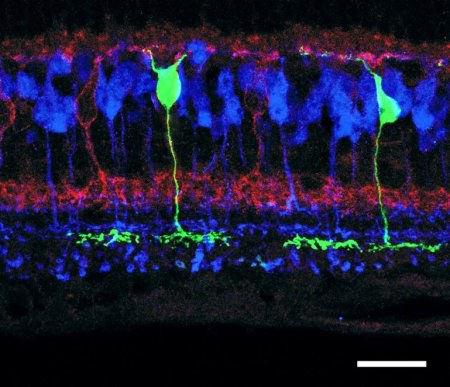Frank Müller
Forschungszentrum Jülich and RWTH Aachen University

Molecular sensory physiology and neurobiology. Cellular signalling in sensory cells and neurons. Biophysics of ion channels and membrane receptors. Information processing in the retina. Electrophysiology and anatomy of the retina of normal and genetically modified animals. Various spectroscopic techniques to study the dynamics of protein function and kinetics of second messenger responses.
Vita
Frank Müller studied biology at the University of Mainz and performed his diploma and doctoral thesis at the Max-Planck-Institute for Brain Research in Frankfurt. Since 1991 he is working in the Institute of Structural Biology and Biophysics 1, Cellular Biophysics, at the Forschungszentrum Jülich where he leads the group "Signal processing in the retina". Frank Müller is Professor of Molecular Sensory Physiology and Neurobiology at the RWTH Aachen. Presently, he is acting director at the Institute of Structural Biology and Biophysics 1 (former name: Institute for Neurosciences and Biophysics 1).
Contact: a.eckert@fz-juelich.de
Research
Biophysics of Cellular Signaling
Download this page as a PDF file (PDF, 69 kB)
Cells represent the smallest entities of the living world. All organisms permanently experience a multitude of extrinsic and intrinsic signals that eventually cause specific changes of the biochemical, biomechanical, or bioelectrical properties of their cells. Therefore, studies how cells interact with external signals are at the very heart of biological signal processing. One of the most demanding challenges in life science research is to uncover and to quantitatively elucidate cellular reactions to a given stimulus with high spatial and temporal resolution. From such analyses we envision to get insight into the physics of the cell.
The research interests of Frank Müller and his colleagues are mostly concerned with cellular and molecular aspects of neuronal functions. In every instant of our life, our nervous system manages incredibly complex tasks. It does this so efficiently that we take its performance as granted and that in daily life we hardly ever think about the mechanisms that underlie our perception and behaviour. Our brain extracts information from hundreds of millions of receptor cells that respond to sensory stimuli. Some of these receptors have achieved a sensitivity that is only limited by the quantal nature of energy and matter. For example, rod photoreceptors in our eye can respond to a single light quantum. On the other hand, our visual sense performs well when 1010 more photons fall into our eye. How is this broad sensitivity range established? What are the molecules inside a sensory cell that translate light or other stimuli first into a biochemical and then into an electrical response? How is sensory information processed? Our brain provides elaborate neuronal networks to analyze sensory input, to create an image of our environment in our mind and to generate our behaviour. For Frank Müller and his colleagues, to understand the biological basis of those processes by which we perceive, act, learn and remember is one of the most interesting and most important tasks in science. But, at the same time, due to the complexity of the processes to be studied, it is one of the most challenging tasks.
If one is to understand the nervous system, one must discover how individual cells of the nervous system and within those cells, how individual signalling molecules work. Müller and his co-workers study the signaling pathways of G-protein coupled receptors, the role of cyclic nucleotide-gated ion channels, signal transduction in sensory cells as well as signal processing in a small neuronal network, the retina. They employ a variety of techniques including molecular biology and biochemistry, confocal laser scanning microscopy, electron microscopy, patch-clamp electrophysiology, an array of spectroscopical and optical imaging methods like calcium imaging, two-photon microscopy of intact retinae in vitro, and the analysis of genetically modified animals. This requires an interdisciplinary team of biologists, chemists, and physicists.

Vision starts when the absorption of light quanta elicits an electrical response in photoreceptors. However, before the signal is relayed from the eye to the brain, it is analyzed within the retina. Already at the very first synapse of the visual system, parallel processing is initiated when photoreceptors relay their information to about 12 different types of bipolar cells. A systematic analysis revealed that each bipolar cell type expresses a unique set of ion channels which in concert shape thecellular response. The retinal network is formed by roughly sixty different cell types and extracts different aspects of information from the image projected onto the retina. What functions do these cell types serve? How are they connected to each other and how do they differ in their physiological properties? How are the different retinal pathways optimized for their function at bright light or star light? Such questions are addressed by Frank Müller and his group.

